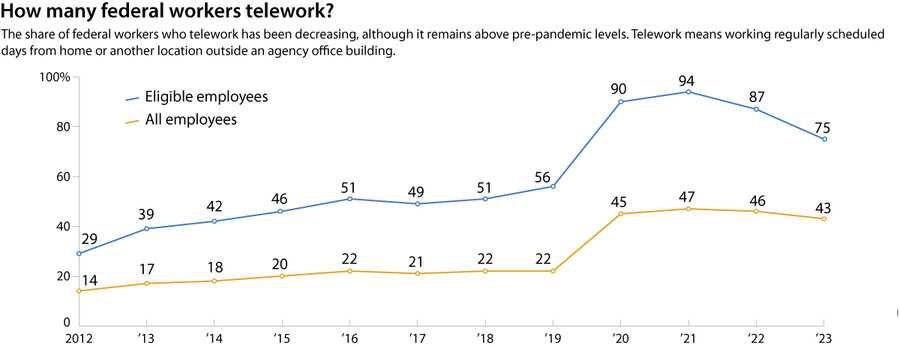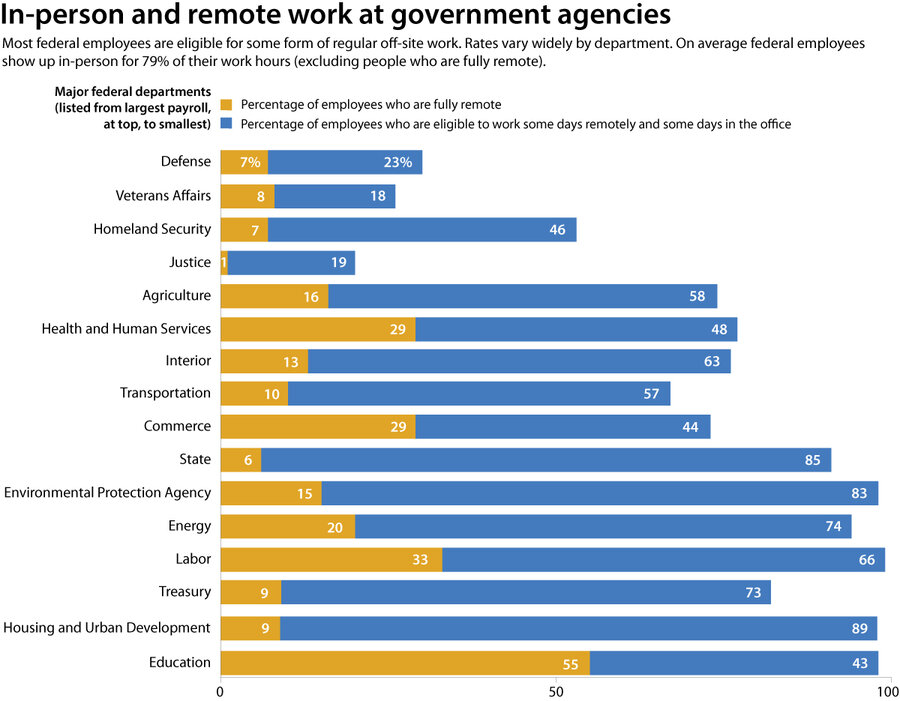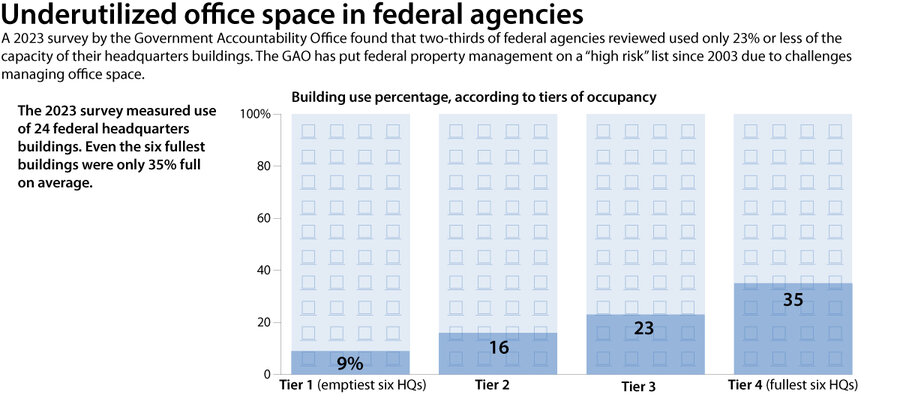
The Trump administration’s disruption of the federal workforce includes a controversial invitation for employees to voluntarily exit their jobs, but it also includes another provocative component: a call for those who stay to get back to the office.
On President Donald Trump’s first day in office, he issued an executive memo ending remote work for federal employees. It was the initial move in a volley of rapid actions aimed at dramatically pruning the federal payroll.
Some deadlines are now coming due: On Friday, federal agencies must submit detailed plans to return employees to the office in phases, starting with people living within 50 miles from a current agency office. Many federal workers had also been facing a Feb. 6 deadline to decide whether to accept a promised buyout offer if they did not wish to return to full-time in-person work. That offer was temporarily halted by a federal judge in Boston on Thursday. The White House said around 40,000 employees (2% of the federal workforce) had accepted the offer before the judge’s order.
Why We Wrote This
Part of President Trump’s remolding of the federal workforce is an in-person work requirement. While government remote work increased during the pandemic, it was trending downward before Mr. Trump’s order.
Trump allies celebrated the return-to-office efforts as a restoration of high standards and government accountability. Meanwhile, Democrats and many federal employees fear it’s meant to get people to quit and is part of a broader attack on the civil service and the expertise that comes with it.
But how common is it for government employees to work from home? A Trump administration directive to federal workers described telework as “virtually unrestricted.” On the other hand, the American Federation of Government Employees, a union representing 800,000 federal workers, says that “lawmakers and members of President Trump’s transition team have spent months exaggerating the number of federal employees who telework.”
Here’s a dive into key questions surrounding how remote work actually happens within federal agencies, how office space is used, and what it may mean for productivity and morale.
Why is remote and hybrid work under fire?
Before the COVID-19 pandemic, about 22% of the federal workforce teleworked, meaning they sometimes worked from home or another approved site away from their main office on regularly scheduled days. That number surged during the pandemic, and has remained almost double prepandemic levels.
A parallel shift toward remote work swept the wider economy – and was seen by many as a threat to worker productivity. And in Washington, Democratic Mayor Muriel Bowser called for bringing federal workers back to their cubicles to help the local economy.
After the election, federal workers came into the spotlight as Elon Musk and Vivek Ramaswamy announced plans to target “unelected bureaucrats” in their new Department of Government Efficiency. (Mr. Ramaswamy has since stepped down as a co-head of DOGE.) In December, Sen. Joni Ernst, a Republican from Iowa, released a 58-page report that accused agencies of allowing federal office space to go to waste and failing to meaningfully track the productivity of remote employees. “In the years since COVID, our nation’s capital has remained a ghost town,” Senator Ernst said during a recent hearing.
In January, the first hearing of the new Congress examined federal work policies. Republican members argued that remote work prevents federal workers from performing at peak capacity. Democrats contended that remote flexibility not only improves workers’ quality of life but also enables federal agencies to recruit more talent.
Democrats have been swift to paint the return-to-office fervor as a strategy to demoralize the federal workforce. Messrs. Musk and Ramaswamy wrote last year that, “Requiring federal employees to come to the office five days a week would result in a wave of voluntary terminations that we welcome.”
How many federal employees have flexible work arrangements?
As of May 2024, about half of the federal workforce was working in roles that didn’t allow for telework, according to the Office of Management and Budget. Ten percent were fully remote. Others worked in hybrid positions, spending the majority of their hours in the office.
A Congressional Budget Office report analyzing data from 2022 found that federal employees teleworked slightly less often than workers in the private sector.
“I think the impression that a lot of people have from listening to Trump and his allies is that every single federal employee is working from home all the time right now, and that’s really far from the truth,” says John Marvel, an associate professor at American University who studies public management.
Republican lawmakers say the number of employees working from home is still high enough to be a burden to taxpayers – and not transparent.
Government agencies don’t have a uniform way of tracking and evaluating employees working remotely. And studies of the effectiveness of flexible work arrangements in the overall U.S. workforce are mixed: The Society for Human Resource Management cites research showing increased productivity and job satisfaction for hybrid workers, for instance, while a Stanford paper notes that fully remote work is at least 10% less productive than in-person work.
However, remote work is often in high demand among job seekers. That’s significant for recruiters in the federal government, where employees are paid 27% less than private-sector workers in the same jobs.
“[Telework] has been a tremendous way to recruit and retain federal workers that the federal government would never be able to keep on the payroll if those programs were not in existence,” says Randy Erwin, national president of the National Federation of Federal Employees.
What about office space?
Many Republicans have cited a 2023 report by the Government Accountability Office that found the majority of government agency headquarters were using 25% or less of their office space. The report cited increased remote work as a major factor, although it mentioned other longstanding challenges, such as building designs that didn’t make sense for a modern workforce and lack of funds to renovate.
Despite calling workers back to offices, the Trump administration has also reportedly directed the General Services Administration to begin terminating leases on the 7,500 federal offices nationwide. The DOGE social media account on X posted last week that the GSA had already ended three leases of “mostly empty office space” for a savings of $1.6 million.
That has raised confusion about where returning employees will work if they do return to the office.
How federal workers are reacting
Mr. Trump’s executive order won’t apply to every single worker. Some employees are protected under collective bargaining telework contracts, and the order also permits agencies to make exemptions they deem necessary. But Mr. Erwin thinks exceptions will be rare.
“We believe that agencies are going to feel great pressure to bring as many federal workers into the physical office as possible,” he says.
Employees at some agencies had already signed collective bargaining agreements that locked in current telework levels through as late as 2029. But an Office of Personnel Management memo on Monday stated that agency heads have the right to determine employees’ level of in-person work regardless of these agreements. In response, the president of the American Federation of Government Employees promised to “aggressively defend” employee contracts.
One government employee at the Department of Justice, who requested anonymity for concern over job security, was hired on the condition that remote work would be available. He is part of a program with more people than available office space, so he and others rotate their time in-person. His superiors don’t yet have a clear plan for how they will fit everyone in the office.
The employee says working from home has helped workers who can’t afford the high cost of rent in downtown Washington and may now have to face arduous commutes.
“There are other people in the division who are sometimes commuting as far as an hour, two hours each morning from nearby cities,” he says. “That impacts your personal life.”
Another Department of Justice employee, who similarly requested anonymity, works in a division that already returned to the office last December to avoid scrutiny from the Trump administration. The employee says there are some benefits to being in-person.
“It just feels fuller, and there’s a sense of camaraderie being built that there probably wasn’t before,” he says. But he adds that the forced return to the office feels “punitive,” and says he’s fortunate compared with others whose lives are more seriously affected. He doesn’t think this is really about the benefits of in-person work.
“The reason all of these are coming down, and everyone knows, is just purely an attrition strategy,” he says. “They’re trying to get, I think, as many people to resign before they start doing mass layoffs.”
The executive order likely won’t be the last thing that makes waves for the federal workforce. Senator Ernst and others have recently introduced bills to relocate certain federal headquarters out of the District of Columbia entirely.









